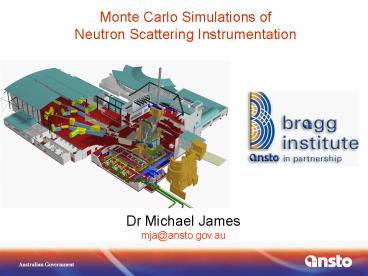Monte Carlo Simulations of - PowerPoint PPT Presentation
1 / 15
Title:
Monte Carlo Simulations of
Description:
Collimation. Optics. Neutron. Guide. 2D Helium-3. Detector. Slit ... Collimation optics. Sample configurations. Disc chopper (neutron pulses) Detector design ... – PowerPoint PPT presentation
Number of Views:74
Avg rating:3.0/5.0
Title: Monte Carlo Simulations of
1
Monte Carlo Simulations of Neutron Scattering
Instrumentation
Dr Michael James mja_at_ansto.gov.au
2
PLATYPUS Time-of-Flight Neutron Reflectometer
2D Helium-3 Detector
Sample Stages Collimation Slits
Slit PackagesBeam Attenuator
Disc Chopper
Neutron Guide
Detector Vacuum Chamber
Collimation Optics
3
PLATYPUS June 2006
4
Monte Carlo Optimisation of Neutron Optics
- Neutron source
- Beam transport (neutron guides)
- Beam shaping slits
- Collimation optics
- Sample configurations
- Disc chopper (neutron pulses)
- Detector design
From source to detector 20 optical
elements (Each element may have 5-6 adjustable
parameters)
5
The Package McStas
6
What is McStas?
- Versatile software for Monte Carlo neutron
ray-tracing simulations - Based on a meta-language
- Translated into simulations codes in ANSI-C
- Library of components for reactor and pulsed
neutron sources - Developed maintained by Risø and ILL.
7
The McStas System
- Model the physical properties of neutrons
interacting with optical components - Model the instrument using components
- Accurate calculation of instrument properties
using Monte Carlo techniques (ray tracing) - Graphical presentation of results
8
- Advantages
- Ability to place detectors and monitors at
any point in the instrument - Ability to graphically follow neutron
trajectories through the instrument - Supported by a variety of platforms PC, Linux
- Constraints
- Flux limitations for simulations 109 n ? 10
hours - (Platypus flux 109 n/s Flight time 30 ms)
- Timely integration of optical components
9
2-D Position Sensitive Detector
Real He-3 neutron detectors are based on capture
10
Vertical and Horizontal Divergence Map
11
Wavelength Spectrum Monitor
12
Flux Limitations 107 neutron trajectories
SIit dimensions 10 mmRun Time 2
minutes(Limited monitors)
13
Flux Limitations 108 neutron trajectories
SIit dimensions 10 mmRun Time 21
minutes(Limited monitors)
14
Flux Limitations 108 neutron trajectories
SIit dimensions 1 mmRun Time 21
minutes(Limited monitors)
15
Summary
- Simulation of basic instrument 6 months
- Each simulation run gt 10 hrs
- Instrument design is a highly interactive process
- Desire to run simulations in minutes, not hours

